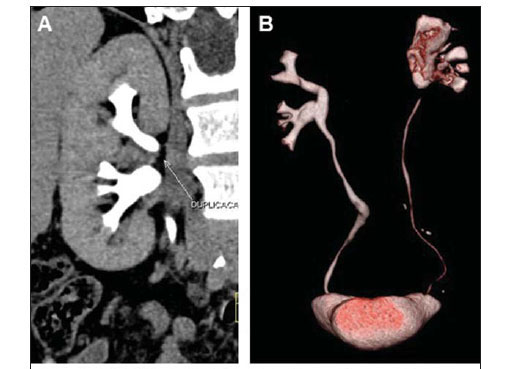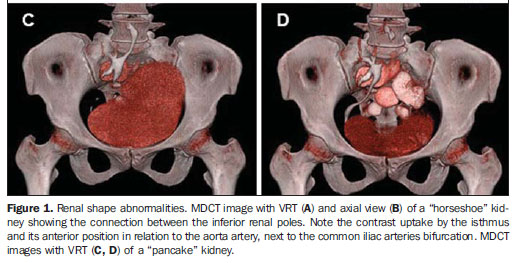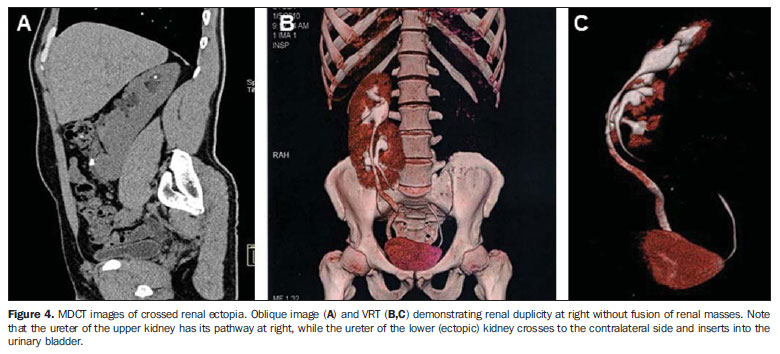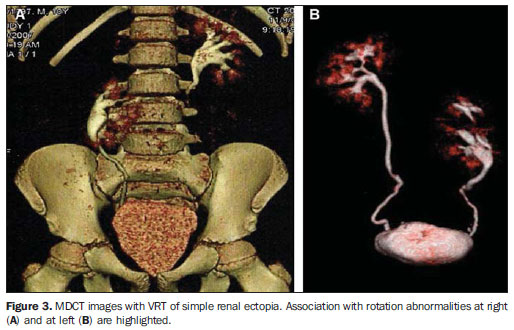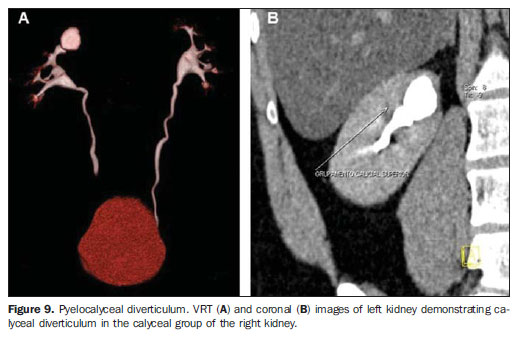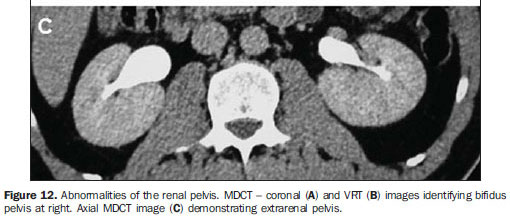Abstracts
Congenital upper urinary tract abnormalities imply a variable clinical spectrum of morphofunctional changes ranging from asymptomatic conditions to renal failure and incompatibility with life. Computed tomography, which has overcome excretory urography imaging, has been playing a key role in the diagnosis of congenital anomalies, serving as a better guidance in the therapeutic and surgical decision-making process, besides acting as an essential tool in the identification of associated complications and aiding in the performance of minimally invasive surgery techniques.
Congenital abnormalities; Urinary tract; Multislice computed tomography
As anomalias congênitas do trato urinário superior implicam modificações morfofuncionais com espectro clínico variável, desde manifestações assintomáticas até falência renal e incompatibilidade com a vida. A tomografia computadorizada, além de ter superado o método de imagem da urografia excretora, tem desempenhado papel fundamental no diagnóstico das anomalias congênitas, orientando melhor nas decisões terapêuticas clínicas e cirúrgicas, além de atuar como ferramenta essencial na identificação de complicações associadas e no melhor desempenho de técnicas operatórias menos invasivas.
Anomalias congênitas; Trato urinário; Tomografia computadorizada multidetectores
REVIEW ARTICLE
Congenital upper urinary tract abnormalities: new images of the same diseases*Carol Pontes de Miranda MaranhãoI; Christiana Maia Nobre Rocha de MirandaII; Carla Jotta Justo dos SantosI; Lucas de Pádua Gomes de FariasIII; Igor Gomes PadilhaIII
ITitular Members of Colégio Brasileiro de Radiologia e Diagnóstico por Imagem (CBR), Physicians at Clínica de Medicina Nuclear e Radiologia de Maceió (MedRadiUS), Maceió, AL, Brazil
IIPhD, Physician at Clínica de Medicina Nuclear e Radiologia de Maceió (MedRadiUS), Professor of Radiology and Imaging Diagnosis at Universidade Federal de Alagoas (UFAL), Maceió, AL, Brazil
IIISixth-year Students at School of Medicine, Universidade Federal de Alagoas (UFAL), Maceió, AL, Brazil
Mailing Address
ABSTRACT
Congenital upper urinary tract abnormalities imply a variable clinical spectrum of morphofunctional changes ranging from asymptomatic conditions to renal failure and incompatibility with life. Computed tomography, which has overcome excretory urography imaging, has been playing a key role in the diagnosis of congenital anomalies, serving as a better guidance in the therapeutic and surgical decision-making process, besides acting as an essential tool in the identification of associated complications and aiding in the performance of minimally invasive surgery techniques.
Keywords: Congenital abnormalities; Urinary tract; Multislice computed tomography.
INTRODUCTION
Embryologically, the urinary and genital systems are closely related to each other, as the nephrogenic cord and the gonadal ridge develop from a longitudinal elevation of the mesoderm at each side of the dorsal aorta(1). About 10% of the individuals are born with potentially significant urinary system malformations(2), and structural and functional changes of development correspond to 20% to 30% of the identified abnormalities in the prenatal period, constituting one of the main causes of renal failure in children(3-5).
Congenital upper urinary tract abnormalities, including the milder forms, are not rare(5). Some abnormality of kidneys and in the ureters occur in 3% to 4% of the newborns, with abnormalities in the kidneys´ position and shape being the most common ones(1). Most of such disorders are only clinically followed-up, hence the necessity of a correct diagnosis of the morphological change as well as a correct evaluation of possible complications.
Formerly, plain abdominal radiography and excretory urography (EU) were the methods of choice for imaging diagnosis of kidneys and urinary tract conditions. However, the introduction of computed tomography (CT) and magnetic resonance imaging (MRI) had a considerable influence on the utilization of imaging methods in the diagnosis and treatment of such conditions. Over the past decade, CT has overcome EU in the evaluation of the genitourinary tract(6-8).
CT is reportedly superior to EU and ultrasonography (US) in the detection and characterization of renal masses(9,10), and its superiority in detecting urinary tract lithiasis has also been recently reported(8,11,12). The only potential limitation of CT - its limited accuracy in the evaluation of the mucosal surface of the renal collecting system and of the ureters -, has been overcome with recent developments of multidetector computed tomography (MDCT), allowing the acquisition of increasingly thinner slices over a short period of time, which implies the utilization of a higher radiation dose. The multiplanar reconstructions and post-processing images of the MDCT apparatuses allow for a more accurate diagnosis(6,13).
The present article is aimed at demonstrating by means of MDCT, the main congenital renal abnormalities which can be detected in patients from both sexes and varied age groups by means of the conventional anatomic planes and volume rendering techniques (VRT).
SIZE ABNORMALITIES
Abnormalities in size, shape and positioning of the kidneys occur at the early stages of development and result from the incorrect union between metanephric blastemas(1).
In cases of hypoplastic kidneys, there is a developmental failure, and in spite of small in size and number, the components of the calyceal system present a normal functioning and keep a relationship with the volume of the parenchyma, characteristics that must be differentiated from acquired atrophic kidney, which is small and contracted. The presence of renal hypoplasia has been associated with infections and arterial hypertension(14,15).
Hyperplasia, another size abnormality, is associated with contralateral agenesis or hypoplasia, and is more appropriately named compensatory hypertrophy(16,17).
SHAPE ABNORMALITIES
As the kidneys migrate into the renal fossa, they cross the umbilical arteries. Any change in the position of such arteries may cause the fusion of nephrogenic blastemas(18), that may be either partial, like in cases of horseshoe kidneys and crossed fused renal ectopia, or total, like in the case of pancake kidneys(19,20).
Horseshoe kidney (Figures 1A and 1B) is the most common and most frequently found renal abnormality among men. Renal fusion occurs at variable degrees, in most cases between the lower poles of the kidneys, which are closer to the midline than in normal kidneys. The isthmus, most commonly located in front of the aorta or of the inferior vena cava, connects the two renal masses, and may contain functioning parenchyma or fibrous tissue, and for such reason a functional evaluation utilizing a radionuclide, may be necessary before any interventional approach. The isthmus itself poses some difficulty for the renal rotation, as well as its ascent due to the inferior mesenteric artery. Its blood supply may be varied and usually the collecting system is anteriorized(1,18-21).
Most patients are asymptomatic and the finding is incidentally observed in the course of imaging procedures. In symptomatic cases, generally hydronephrosis (Figure 2), infection or development of calculi are reported. Such abnormality has been associated with a higher predisposition to development of malignant neoplasms, such as Wilms' tumor, as well as systemic malformations, as in the case of Turner's syndrome(1,18,20).
In cases of abnormality characterizing pancake kidneys (Figures 1C and 1D), the kidneys form a single medial mass located in the pelvic cavity or at the level of the aortic bifurcation, with a flat, lobulated and non-reniform appearance, with anteriorized collecting system and short ureters draining into independent orifices or into a single ureter(20). Its blood irrigation, also anomalous, is a risk factor for the renal vascular length, from the event of a simple gestation to pelvic traumas(19).
Thus, the identification of renal fusion abnormalities do not necessarily imply a worst prognosis, but they should be identified as early as possible for evaluation of concomitant conditions, as well as for differential diagnoses simulating pelvic mass which cannot be unequivocally removed or injured(19).
POSITION ABNORMALITIES
The ectopic kidney (Figures 3 and 4) is the result of failure in its migration from the pelvic cavity towards the renal fossa(15) and is frequently related to poor rotation(14,18). A slightly higher prevalence of such abnormality in the left side is observed, and 10% of cases may be bilateral(18).
Cranial ectopia is usually intrathoracic, and caudal ectopia can be classified into abdominal, iliac (lumbar) and pelvic (sacral), the latter being most frequently found(15), besides the association with genital malformations(14).
In cases of congenital renal ectopia, the lower positioning of the kidney position is associated with a shorter ureter, renal vessels with ectopic origin (adjacent blood vessels, sometimes irrigated by multiple vessels) and some degree of collecting system malformation(1,18), increasing the susceptibility to reflux, infection, lithiasis and obstructive conditions(2). It should neither be confused with abnormally mobile kidney nor with ptotic kidney(18).
In simple ectopia (Figure 3), the kidney is at the same side in which it originated. The pelvic location, the most common one, is associated with the absence of its habitual morphology as the kidney is frequently malrotated and has its image superimposed over the pelvic bones, which makes its identification difficult(18).
Crossed renal ectopia (Figure 4) occurs when one of the kidneys is contralateral in relation to the site of insertion of its ureter into the urinary bladder. Almost always, the ectopic kidney has a shorter ureter, and, therefore, a lower position as compared with the normal kidney, which may present varied degrees of ptosis and malrotation. The normal kidney may remain separated from the ectopic kidney or form a single mass with the ectopic one(14,15). Crossed renal ectopia with fusion (85% of the cases) can be identified in several presentations, with the most common one being the fusion of the upper pole of the ectopic kidney with the inferior pole of the other(18,20).
ROTATION ABNORMALITIES
The kidney migration from the pelvic cavity into its definitive location at the lumbar site, occurs simultaneously with its rotation in the longitudinal plane. Each kidney undergoes a medial rotation of approximately 90º as it migrates cephalically. Thus, the hila are oriented towards the midline, aligned and anteromedially oriented towards each other(1,18). It is important to establish a correct diagnosis in order to rule out other pathological conditions which may cause similar distortion in the kidneys(18).
Renal malrotation (Figure 5) is commonly associated with an ectopic kidney or fusion, besides the possibility of partial obstruction of the pelvis and the kidneys' ureters. Both kidneys may be affected, and incomplete rotation or nonrotation at all are more frequently observed as compared with other subtypes(18). Rarely, there is a hyper-rotation, placing the renal hilum towards the dorsum(15).
NUMBER ABNORMALITIES
Renal agenesis, with a probable multifactorial etiology, is defined as the absence of renal tissue secondary to embryogenesis failure, occurring either unilateral or bilaterally(1). Supernumerary kidney is extremely rare, is separated from the normal kidney and has its own blood supply(14).
Unilateral agenesis (Figure 6) is a relatively common abnormality, occurring approximately once in every 1,000 newborns(1). The prognosis is good when the condition is not associated with other systemic abnormalities and is related to a contralateral, usually hypertrophic kidney, as a compensatory effect(1,2). Agenesis of the ipsilateral adrenal gland is found in 10% of the cases(22) and the renal artery and vein do not develop. The corresponding ureter is absent in most cases, sometimes corresponding to a fibrotic cord which may end ectopically, for example, in the contralateral seminal vesicle(15). One should suspect of unilateral renal agenesis in children with only one umbilical artery(1).
Bilateral agenesis occurs once in every 3,000 newborns, is incompatible with life, and is generally found in stillborns(1,2). Such children present a characteristic facial appearance(1,23) and frequently there are association with other congenital disorders, like in the case of Potter's syndrome(2,24). Fetal urine is not produced, resulting in severe oligohydramnios(24).
LOBAR ANATOMY ABNORMALITIES
Renal cortical defects such as persistent fetal lobulation, "dromedary hump" and hypertrophied column of Bertin represent frequent anatomic variations of the renal parenchyma and may simulate renal tumors, with an otherwise healthy parenchyma(21,23) (Figure 7).
Renal contour lobulations (Figure 7A) are found in approximately 5% of adults submitted to kidney imaging studies(23). Such abnormality corresponds to persistence of well defined cortical sulci on the renal surface which are found in the fetal kidney and usually disappear during the childhood as a consequence of growth and increase in the number of nephrons(1). It may also be confused with renal scars(23,25).
On the other hand, dromedary hump kidney (Figure 7B) is characterized by a change in the shape and contour of the posterolateral aspect of the left kidney, as a consequence of a focal prominence of the renal parenchyma, probably due to impression of the spleen in the course of fetal life(23,25).
Another benign condition which may simulate neoplasia is hypertrophied column of Bertin (Figures 7C and 8), which correspond to columns of renal cortical tissue located between the pyramids, and resulting from fusion of two or more renal lobes. Such columns may be thicker, hypertrophic and deep, protruding in the renal sinus and manifesting as a regular and well defined cortical nodule located at the junction between the upper and medial renal thirds(23,26).
Hypertrophied column of Bertin presents suggestive, but nonspecific signs at EU and US, so CT(25), whose findings are well characterized, should be performed. Such CT findings are isodense in relation to the cortical parenchyma and the postcontrast uptake is uniform.
ABNORMALITIES OF THE CALYCES AND PAPILLAE
The pyelocalyceal diverticulum is a cystic cavity covered by urothelium, located inside the renal parenchyma, which may be either acquired or congenital (most common) and single or multiple(2,15). Such abnormalities may be divided into two types, as follows: 1) the most frequent one is represented by minor lesions affecting the minor calyces, and are located close to the region of the upper renal pole (Figure9); 2) the less frequent one, centrally located in the kidneys, is related to the renal pelvis or major calyces(27,28).
Minor diverticula are typically asymptomatic, and are incidentally found at imaging studies. The major ones are generally symptomatic and urinary stasis favors the development of urinary infection and formation of calculi(2,27). While the incidence of pyelocalyceal diverticulum is low, the frequency of associated calculi formation is high(29).
ABNORMALITIES OF THE RENAL PELVIS AND OF THE URETER
The renal collecting system is a frequent site of anatomic variations with respect to size, shape, degree of ramification and degree of rotation in relation to the renal hilum.
Ureteropelvic junction (UPJ) stenosis (Figure 10) is the most common abnormality in the childhood and is more frequent in male children, normally being diagnosed at the first year of life, sometimes remaining undetected until adulthood, and in such age range it is more frequently found in women(1,22). Such abnormality is characterized by narrowing of the UPJ, generally at left, and may be caused either by an intrinsic muscle lesion or by a functional discontinuity in this segment, impairing the appropriate emptying of the renal pelvis, leading to hydronephrosis(15,22).
The stenosis may also be determined by a pyeloureteral mucous fold with valvular behavior, or by extrinsic compression by an aberrant vessel which compresses the infundibulum of the renal pelvis, impairing its emptying(15). It is one of the main causes of urinary tract dilation (approximately 35% to 40% of the cases) and its origin is still to be completely understood(18).
However, in most of cases, renal pelvis and ureter abnormalities present as duplicity of the collecting system, a common cause of dimension asymmetry between the kidneys during the childhood, which occurs in 1% to 2% of the population, most frequently among female individuals(15,22,30). Such duplicity may be complete or incomplete (Figure 11), with higher prevalence for the unilateral presentation, and is frequently associated with various complications(22,30). The kidney with duplicated collecting system is larger, particularly along its longitudinal axis, and likewise the volume of the parenchyma.
In cases of complete duplicity (Figures 11A and 11B), there are two collecting systems for a single kidney, and two ureters at the same side, draining into separate orifices. According to the Weigert-Meyer rule (Figure 11B), the ureter which drains the upper part goes over the urinary bladder wall to insert itself inferiorly and medially in relation to the normal insertion site. Frequently, such an insertion is defective, associated with ureteroceles and, when ectopic, it may drain into the posterior uretra, vagina or the vulva. The ureter of the lower segment inserts close to the normal site and is subject to vesicoureteral reflux because of the distortion it undergoes as it crosses the urinary bladder wall associated with ureteroceles(15,22). At radiography, the complete dilation is seen as the characteristic and well known dropping lily sign(21).
Complications from complete duplication include infections, vesicoureteral reflux and UPJ obstruction. Reflux in the collecting system of the lower segment may cause scars and deformities in that segment(22).
In incomplete duplicity (Figure 11C) there are two collecting systems and two ureters that fuse together at any level between the kidney and the bladder (normally in the lower third of that pathway), originating a single ureter which drains normally into the vesical base. In cases where the junction is at a level above the vesical dome, the ureter presents a "Y" configuration, and in cases where the junction occurs at the level of the intramural segment of the ureters, the ureter presents a "V" configuration(15,22). There may be uretero-ureteral reflux because of the ureteral peristalsis asynchrony before the confluence.
Pelvic anomalies are other abnormalities resulting from the division of the collecting system (Figure 12). In cases of bifidus renal pelvis (Figures 12A and 12B) only the renal pelvis is divided and there is only one UPJ. This is a relatively common anomaly, which occurs in up to 10% of the population and there is no association with other anomalies(22). The position of the renal pelvis is also quite variable. Te pelvis is classified as intrarenal when there is abundant renal tissue around it. On the other hand, the pelvis is extrarenal (Figures 12C and 12 D) (more common), when it is actually outside the hilum which is occupied only by the calyceal infundibula. In general, it is associated with other anomalies such as malrotation or position defects, with the possibility of stasis and predisposition to infections(22).
CONCLUSION
Many of the morphological renal changes can be evaluated by means of US and EU, but CT, with its more modern technological resources, has contributed over the past years for a better characterization of morphological changes. Computed tomography is essential in the diagnosis of congenital abnormalities, offering a better guidance in the clinical and surgical/therapeutic decisions making process, additionally to its role as a relevant tool for identifying associated complications. Also, the several resources of this imaging method allow for renal evaluation with respect to size, position and shape.
The present article demonstrates how the new images from the same congenital renal abnormalities have contributed for a more accurate diagnosis and better evaluation of associated complications in such patients.
REFERENCES
- 1. Moore KL, Persaud TVN. Embriologia clínica. 6Ş ed. Rio de Janeiro, RJ: Guanabara Koogan; 2000.
- 2. Kumar V, Abbas AK, Fausto N. Robbins e Cotran - Patologia: bases patológicas das doenças. 7Ş ed. Rio de Janeiro, RJ: Elsevier; 2005.
- 3. Reidy KJ, Rosenblum ND. Cell and molecular biology of kidney development. Semin Nephrol. 2009;29:321-37.
- 4. Sanna-Cherchi S, Ravani P, Corbani V, et al. Renal outcome in patients with congenital anomalies of the kidney and urinary tract. Kidney Int. 2009;76:528-33.
- 5. Prando A, Prando D, Caserta NMG, et al. Urologia: diagnóstico por imagem. São Paulo, SP: Sarvier; 1997.
- 6. Caoili EM, Cohan RH, Korobkin M, et al. Urinary tract abnormalities: initial experience with multi-detector row CT urography. Radiology. 2002;222:353-60.
- 7. Nikken JJ, Krestin GP. MRI of the kidney - state of the art. Eur Radiol. 2007;17:2780-93.
- 8. Galvão Filho MM, D'Ippolito G, Hartmann LG, et al. O valor da tomografia computadorizada helicoidal sem contraste na avaliação de pacientes com dor no flanco. Radiol Bras. 2001;34:129-34.
- 9. Warshauer DM, McCarthy SM, Street L, et al. Detection of renal masses: sensitivities and specificities of excretory urography/linear tomography, US, and CT. Radiology. 1988;169:363-5.
- 10. Jamis-Dow CA, Choyke PL, Jennings SB, et al. Small (< or = 3-cm) renal masses: detection with CT versus US and pathologic correlation. Radiology. 1996;198:785-8.
- 11. Smith RC, Verga M, McCarthy S, et al. Diagnosis of acute flank pain: value of unenhanced CT. AJR Am J Roentgenol. 1996;166:97-101.
- 12. Levine JA, Neitlich J, Verga M, et al. Ureteral calculi in patients with flank pain: correlation of plain radiography with unenhanced helical CT. Radiology. 1997;204:27-31.
- 13. Kawashima A, Sandler CM, Ernst RD, et al. CT evaluation of renovascular disease. Radiographics. 2000;20:1321-40.
- 14. Barbaric ZL. Principles of genitourinary radiology. 2nd ed. New York, NY: Thieme; 1994.
- 15. Kim SH. Radiology illustrated - uroradiology. 2nd ed. Berlin: Springer-Verlag; 2012.
- 16. Hartshorne N, Shepard T, Barr M Jr. Compensatory renal growth in human fetuses with unilateral renal agenesis. Teratology. 1991;44:7-10.
- 17. Cho JY, Moon MH, Lee YH, et al. Measurement of compensatory hyperplasia of the contralateral kidney: usefulness for differential diagnosis of fetal unilateral empty renal fossa. Ultrasound Obstet Gynecol. 2009;34:515-20.
- 18. Fotter R. Pediatric uroradiology. 2nd ed. Berlin: Springer-Verlag; 2008.
- 19. Gun S, Ciantelli GL, Takahashi MAU, et al. Fusão renal completa em criança com infecção recorrente do trato urinário. Radiol Bras. 2012;45:233-4.
- 20. Türkvatan A, Ölçer T, Cumhur T. Multidetector CT urography of renal fusion anomalies. Diagn Interv Radiol. 2009;15:127-34.
- 21. Dyer RB, Chen MY, Zagoria RJ. Classic signs in uroradiology. Radiographics. 2004;24 Suppl 1: S247-80.
- 22. Brant WE, Helms CA. Fundamentals of diagnostic radiology. 3rd ed. Philadelphia, PA: Lippincott Williams & Wilkins; 2007.
- 23. Quaia E. Radiological imaging of the kidney. 1st ed. Berlin: Springer-Verlag; 2011.
- 24. Zhou Q, Cardoza JD, Barth R. Prenatal sonography of congenital renal malformations. AJR Am J Roentgenol. 1999;173:1371-6.
- 25. Bhatt S, MacLennan G, Dogra V. Renal pseudotumors. AJR Am J Roentgenol. 2007;188:1380-7.
- 26. Lafortune M, Constantin A, Breton G, et al. Sonography of the hypertrophied column of Bertin. AJR Am J Roentgenol. 1986;146:53-6.
- 27. Rathaus V, Konen O, Werner M, et al. Pyelocalyceal diverticulum: the imaging spectrum with emphasis on the ultrasound features. Br J Radiol. 2001;74:595-601.
- 28. Abad PG, González IF, Peso AC, et al. Percutaneous treatment of stone-containing calyceal diverticulum. Arch Esp Urol. 2009;62:42-8.
- 29. Stunell H, McNeill G, Browne RF, et al. The imaging appearances of calyceal diverticula complicated by uroliathasis. Br J Radiol. 2010;83:888-94.
- 30. Fernbach SK, Feinstein KA, Spencer K, et al. Ureteral duplication and its complications. Radiographics. 1997;17:109-27.
Publication Dates
-
Publication in this collection
26 Feb 2013 -
Date of issue
Feb 2013
History
-
Received
16 June 2012 -
Accepted
08 Oct 2012


